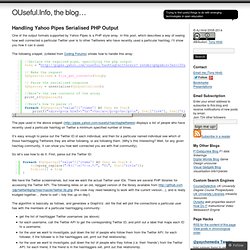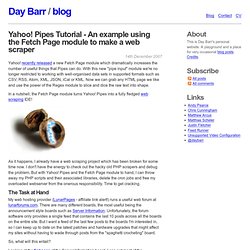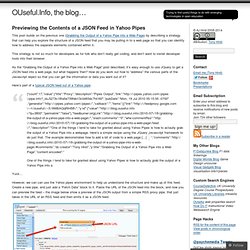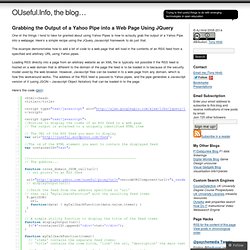

Handling Yahoo Pipes Serialised PHP Output. One of the output formats supported by Yahoo Pipes is a PHP style array.

In this post, which describes a way of seeing how well connected a particular Twitter user is to other Twitterers who have recently used a particular hashtag, I’ll show you how it can b used. The following snippet, (cribbed from Coding Forums) shows how to handle this array: The pipe used in the above snippet ( displays a list of people who have recently used a particular hashtag on Twitter a minimum specified number of times.
It’s easy enough to parse out the Twitter ID of each individual, and then for a particular named individual see which of those hashtagging Twitterers they are either following, or are following them. (Why’s this interesting? So let’s see how to do it. We have the Twitter screennames, but now we want the actual Twitter user IDs. For completeness, here are the Twitter object methods and their associated Twitter API calls that were used in the above code: Pipes Blog » Blog Archive » New Yahoo! Pipes PHP serialized output renderer. Until now JSON output has been the only way to obtain all the data flowing through a Pipe.
Starting today we’ve added a second way of getting all the data – serialized PHP Pipe output. To get this, go to your Pipe -> More options -> Get as PHP. Right click the “Get as PHP” link to copy link location (or copy shortcut if using IE). After obtaining the link location, you can do something as simple as this to get Pipe output data as an array into your PHP script. // Pipes Request $req = ' // Make the request $phpserialized = file_get_contents($req); // Parse the serialized response $phparray = unserialize($phpserialized); To view the array in your web browser, use this piece of PHP code to help visualize the array. print_r($phparray); Backup and Run Yahoo Pipes Pipework on Google App Engine. Www.lotontech.com/computing. Day's blog - Yahoo! Pipes Tutorial - An example using the Fetch Page module to make a web scraper.
Yahoo!

Recently released1 a new Fetch Page module which dramatically increases the number of useful things that Pipes can do. With this new "pipe input" module we're no longer restricted to working with well-organised data sets in supported formats such as CSV, RSS, Atom, XML, JSON, iCal or KML. Now we can grab any HTML page we like and use the power of the Regex module to slice and dice the raw text into shape. Embedding the Output of a Yahoo Pipe in Your Own Webpage. I’ve demonstrated previously a way of using JQuery to pull the JSON (Javascript Object Notion) output of a Yahoo pipe – a Javascript version of an RSS feed, essentially – into a web page (Previewing the Contents of a JSON Feed in Yahoo Pipes), but if the idea of tinkering with JQuery is one step towards coding hell to far, what are the alternatives?

One approach is to grab the RSS output of a pipe and use it as the RSS URL in Feed2js, which will let you customise a review display of the output of the pipe and give you a handy Javascript embed code for the display that you can embed in your own page. I don’t know why, but I keep forgetting the Yahoo pipes itself offers a couple of widgets – referred to as “badges” – for displaying the output of a pipe in your own web page: Yahoo Pipes Badges how to. Like this: Like Loading...
Previewing the Contents of a JSON Feed in Yahoo Pipes. This post builds on the previous one (Grabbing the Output of a Yahoo Pipe into a Web Page) by describing a strategy that can help you explore the structure of a JSON feed that you may be pulling in to a web page so that you can identify how to address the separate elements contained within it.

This strategy is not so much for developers as for folk who don’t really get coding, and don’t want to install developer tools into their browser. Yahoo pipes JSON browser. Grabbing the Output of a Yahoo Pipe into a Web Page Using JQuery. One of the things I tend to take for granted about using Yahoo Pipes is how to actaully grab the output of a Yahoo Pipe into a webpage.

Here’s a simple recipe using the JQuery Javascript framework to do just that. Pipes - Badge Documentation. What is a Yahoo! Pipes badge? A Yahoo! Pipes badge allows you to have Pipes generated content on your blog, website or social network. What kind of badges are available? Currently there are 3 badges. List badge A simple list of items. How do I add the badge to my page? You can add the badge automatically to your blogger, typepad or igoogle page, by using our "Get This" wizard. Are there any limitations of the badge? Badges are best viewed with A-grade browsers. How do I style my badge? Surround badge with a div tag Examples The easiest way of styling a badge is to surround the script badge code with a div tag and assign a class to it.
Edit script node properties Examples You can also add properties to the script node and change various parameters defined below. Rendered badge HTML structure with class names.